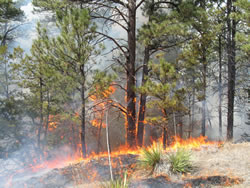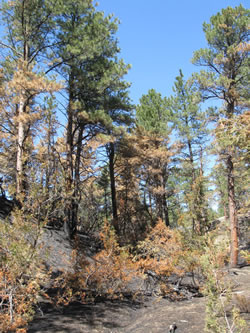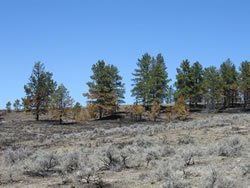
National Fire Plan Success Story
Central Montana - Cottonwood Creek Prescribed Burn, A Collaborative Effort
Montana
National Fire Plan - Fuels Reduction
2010

Under-burning ponderosa pine on the Cottonwood Creek prescribed burn.

Results of the under-burn within mature pine stands. Understory juniper and pine seedlings have been reduced to improve fire regime condition classes.

Results of the under-burn in savanna and rangeland areas. Sprawling savanna has been checked.
The Cottonwood Creek project was a cooperative effort between the BLM, Rocky Mountain Elk Foundation, the National Wild Turkey Federation, and the agencies that helped carry it out, the local U.S. Fish and Wildlife Service, BLM, and rural fire department. The project included 1,787 acres of ponderosa pine forests and savanna and conifer-encroached rangelands in the Musselshell Breaks area of central Montana. Variations in fuel loadings and arrangement resulted in a mosaic of burned and unburned areas. Mature ponderosa pine stands were retained while the density of pine seedlings and juniper in the understory and in the open rangelands were reduced. The burn resulted in a reduction of ladder fuels and overall fuel loadings.
Prior to burning, the fire regime condition class of the ponderosa pine stands in the vicinity and within the unit were assessed at condition class 2, bordering condition class 3. As a result of the prescribed burn, condition class 2 areas have been improved to a condition class 1, or maintained/improved to a condition class 2. This area receives some of the heaviest lightning ignitions in the zone, so in the event of a wildfire, the area will be less susceptible to high severity stand-replacement fire behavior.
Spring and fall turkey hunters have been seen flocking to the area.
Contact: Pat Harty, Fuels Specialist 406-538-1983; Jennifer Walker, Fire Ecologist 406-538-1982